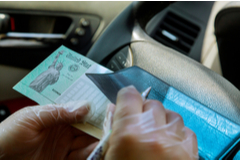IRS direct deposit
Editor’s Note: For those seeking IRS direct deposit information regarding stimulus payments, please visit our stimulus check direct deposit page.
Getting a tax refund is welcome news for any taxpayer. If you’re expecting money back, you might consider having it electronically deposited into your account. An IRS direct deposit is a convenient way to receive your refund quickly and securely.

IRS direct deposit is a popular option for many U.S. taxpayers. In fact, according to information from the IRS, eight out of 10 taxpayers choose this method to receive their refund.
Tax refund direct deposit — The benefits
Choosing to have your refund electronically transferred has many benefits over receiving your money as a check in the mail.
- One of the clearest advantages of direct deposit is that you can receive your money faster than you would if you were to wait for your check to arrive in the mail.
- Another benefit is that choosing a tax refund direct deposit allows you to receive your money safely and securely. With concerns of identity theft and fraud on the rise, IRS direct deposit means you don’t have to worry about mail theft, which could put your check and your personal information at risk.
- Direct deposit can also help you manage your finances and save for the future. Because the IRS lets you split your refund across two or three accounts, you can take one step out of the process of investing. For example, you could have a portion of your refund put into your checking account for everyday expenses and the other portions put into a savings account or a retirement account, such an IRA.
How to set up direct deposit with the IRS
If you’re using H&R Block tax software or you opt file taxes online with us, simply choose direct deposit as your return method. You’ll need to provide your bank or financial intuition’s routing number and your account number. These numbers can be found at the bottom of your check or deposit slip. The routing number is the first series of numbers listed and is nine-digits in length. The next set of numbers is your account number.
Keep in mind that you will not be able to change this information once you’ve submitted your tax return. That said, you should double check the routing and account number to avoid any errors. Additionally, it’s important to know that you can only have your tax refund deposited into an account in your name —direct deposit into someone else’s account is not allowed
Get expert help with your tax return
You can rely on H&R Block’s expertise whether you file in an office or with one of our easy-to-use online filing products.
Make an Appointment to speak with a Tax Pro or review our options to file your taxes online.
Was this topic helpful?
